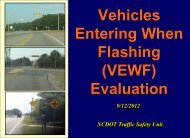Concept of Operations for Intersection Conflict Warning ... - Enterprise
Concept of Operations for Intersection Conflict Warning ... - Enterprise
Concept of Operations for Intersection Conflict Warning ... - Enterprise
You also want an ePaper? Increase the reach of your titles
YUMPU automatically turns print PDFs into web optimized ePapers that Google loves.
conducted. It is also expected to serve as preliminary guidance <strong>for</strong> what may eventually be included inthe Manual on Uni<strong>for</strong>m Traffic Control Devices (MUCTD) and the Highway Safety Manual.1.2 StakeholdersThe deployment and operation <strong>of</strong> ICWS will be driven by the needs <strong>of</strong> the stakeholder groups who willinteract with them. Such needs have been identified <strong>for</strong> two primary groups – drivers and transportationagencies.Drivers <strong>of</strong> the major and minor roads at stop-controlled intersections equipped with ICWS; andTransportation agencies at the state, county and local level that will operate, maintain and ownthe ICWS.Industry who may design, manufacture and install ICWS <strong>for</strong> transportation agencies.Law en<strong>for</strong>cement who may observe operation <strong>of</strong> and driver compliance with ICWS.As national groups like the National Committee on Uni<strong>for</strong>m Traffic Control Devices consider the need <strong>for</strong>and content <strong>of</strong> ICWS standards, a concept <strong>of</strong> operations will clearly articulate the fundamental needsand concept <strong>of</strong> the systems. This concept <strong>of</strong> operations is intended to articulate the basic needs andoperational concept surrounding ICWS. It does not mandate the deployment <strong>of</strong> such systems, nor doesit limit the engineering or policy discretion <strong>of</strong> the transportation agencies who may consider deployingICWS. This document reflects stakeholder needs based on known practice nationally and should beadapted as necessary to reflect any unique or additional needs driven by individual deployments. Theremainder <strong>of</strong> this concept <strong>of</strong> operations documents the needs <strong>of</strong> the noted stakeholder groups,describes an operational concept from the stakeholder perspectives, outlines systems componentsand presents common operational scenarios <strong>for</strong> ICWS that provide both major and minor road alerts.2. NeedsThis section presents system needs according to stakeholder groups. These needs will drive what thesystem must do and they will further define the system requirements <strong>for</strong> how ICWS must per<strong>for</strong>m. Table1 lists stakeholder needs that are identified by first describing a challenge facing one or more <strong>of</strong> thestakeholders (column 1). Then, based on each challenge, one or more needs (column 3) are described.Each need is also numbered (column 2) <strong>for</strong> identification and traceability purposes. The needs arereferenced later in this document within in the operational concept and the list <strong>of</strong> proposed systemcomponents. The need identification allows each subsequent reference to be traced back to an originalneed and corresponding challenge.Table 1 Stakeholder Needs <strong>for</strong> ICWSChallenge ID NeedMajor road drivers approaching anintersection may not see or be aware <strong>of</strong>vehicles at stop signs or yield signs on theminor road.1Major road drivers approaching an intersectionequipped with ICWS need an alert to indicate whenvehicles are approaching, at stop signs, or at yieldsigns on the minor road.<strong>Concept</strong> <strong>of</strong> <strong>Operations</strong> <strong>for</strong> <strong>Intersection</strong> <strong>Conflict</strong> <strong>Warning</strong> Systems Page 3




